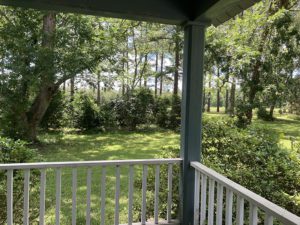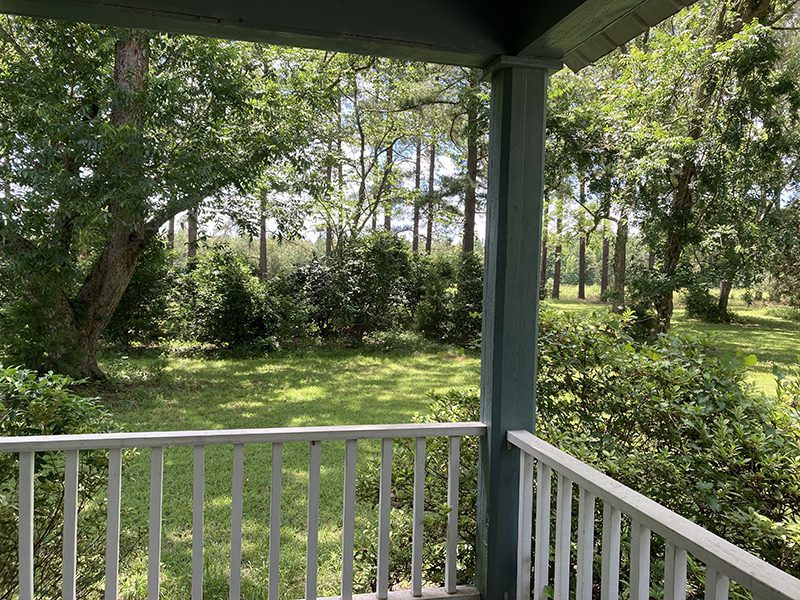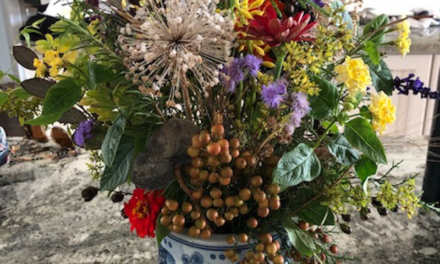 Despite occasional days of unsuitable weather, this spring and the opening of summer have offered some glorious opportunities at the old farmhouse for sitting on the broad rocking-chair porch, taking in the moment’s offerings of wrens’ chirps or owls’ hoots, of the snow-drifts of fallen pear blossom petals, and this year’s brilliant, copious display of azaleas across the full expanse of the porch.
Despite occasional days of unsuitable weather, this spring and the opening of summer have offered some glorious opportunities at the old farmhouse for sitting on the broad rocking-chair porch, taking in the moment’s offerings of wrens’ chirps or owls’ hoots, of the snow-drifts of fallen pear blossom petals, and this year’s brilliant, copious display of azaleas across the full expanse of the porch.
Our azalea show seems usually to coincide with the Masters in Augusta, so we smile a little smugly those years when the Augusta azaleas are out of synch with the televised spectacle, our little extravaganza outdoing that justly famous one across the Savannah River.
The rest of the 5-acre yard has camellias dominating the shady spots, old-fashioned mop-head hydrangeas line the big screened back porch, and these azaleas – nothing special, just the classic Formosa in its tactless magenta glory – are only here, backed by the white porch railing and the blue-grey-green of the old house itself.
And it is an old house, approaching the beginning of its third century, as I unpleasantly discovered a year or two ago when I leaned against the front porch railing and fell straight onto one of the big azaleas. Nearly impaling myself, my body broke thick vertical branches into spears. I escaped with my chest and stomach looking as if I’d been mauled by a bear.
We took the opportunity to replace the old porch railing, and now the front porch, with its view of the expanse of lawn, the camellia gardens, and the woodlands beyond, is precisely what a sitting porch is supposed to be.
The azaleas, however, have reached the point of marring the perfection of the scene. Formosa can be a rampant grower, and if allowed to do so, it would eventually reach the roof line. It’s time to prune.
Well, it may actually be past time to prune. Azaleas (and camellias, too) are usually recommended for pruning right after they finish blooming. This makes good sense, since both azaleas and camellias begin their new growth shortly after the blooms fall – and shortly after they start their new growth, they start forming next year’s flowers in the growing stem. If we cut the stems that are making the new year’s growth, we may cut off the embryonic flowers that are also forming.
For azaleas, early to mid-July, is the suggested end date for pruning. Camellias bloom earlier, and – depending on variety and bloom time – their last pruning date is usually set for April or May.
Sometimes, though very rarely of course, I may have been just a little tardy in taking care of garden chores; I have sometimes had to face vastly overgrown azaleas and camellias, and I realize I have missed the “cut-off” date for pruning. What to do?
The solution involves a little sacrifice. The cut-off date marks the time that the plants start making next year’s blooms. If you’re willing to forego one season’s flowering show – if you can manage not having the usual competition with the Masters Tournament – the bloom the following year should be even better. The shrubs themselves will also be a more manageable size. And the gardener will be happy once again.
There are other things to consider when you decide to prune any shrub. And I have just the solution for you. For any gardening question, you have at your fingertips a fantastic resource for information on virtually any gardening subject, and the information is specifically for South Carolina gardeners’ situations. It’s not offering solutions to gardening in California or Vermont.
I’m talking about the Home and Garden Information Center at Clemson University, which combines the very best knowledge of experienced gardeners and the most up-to-date science-tested information on thousands of topics.
All you need to do is go to www.HGIC.edu. There’s a search bar for you to look up anything, and general areas of interest to cover almost anything of interest.
Don’t forget that you also have your local Clemson Extension Office and your faithful, wonderful Lowcountry Master Gardeners to pepper with your questions. Always keep growing!











